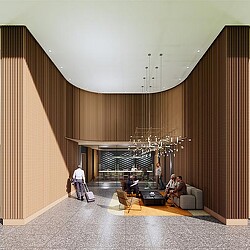Trends to Watch: The Future of Entertainment in the Built Environment
Gensler’s Entertainment leaders discuss the opportunities shaping the future of entertainment, from immersive experiences to entertainment districts.

Editor’s Note: This blog is part of our Design Forecast blog series, looking at what’s next in 2025 and beyond.
Demand for immersive, in-person experiential entertainment has grown so much in recent years that the entertainment industry has ratcheted up its partnerships with hotels, restaurants, retail stores, and wellness outlets. Meanwhile, operators of traditional entertainment venues are seeking new ways to repurpose existing spaces to cater to the next generation of audiences. We sat down with Ann Morrow Johnson and Lexi Barry, global leaders for Gensler’s Entertainment practice, to discuss the trends shaping the future of the entertainment industry and how opportunities for immersive experiences and unique storytelling can provide a competitive edge.
How is the entertainment industry converging with other industries?
Ann Morrow Johnson: We’re seeing a lot of interesting stuff in the cultural center space exploring how museums or cultural heritage monuments invite in a new generation of people, or theater and performance venues that are trying to think about what the next generation of entertainment is. How do we think about engagement, invitation, and immersion in these spaces? These organizations are drawing on learnings from immersive experiences and experiential design and apply that thinking to their spaces in a way that helps them invite in the next generation of audiences to their worlds — whether that’s a special event that allows you to see a collection up close and personal or coming in at odd hours with different lighting and feeling like you’re getting to see something special. It doesn’t take a tremendous amount of production infrastructure or cost. It just takes inviting people in in a slightly new way that makes you feel like you can participate in new and exciting ways.
City centers are embracing experiential entertainment to help reinvigorate distressed assets and mixed-use developments. Tools such as theatrical design, entertainment, and emotional placemaking can help marry the magic of a place with its reality — giving people a reason to explore, engage, and spend time in these developments.
Lexi Barry: Additionally, we’re starting to see the idea of immersive wellness become a trend. As wellness becomes more specialized and more experience focused, the idea of being curators in this space is increasingly part of the sort of cultural zeitgeist. In the hospitality world, positioning is getting more niche and more specific. Whether it’s a wellness getaway or a sound bath yoga retreat — there are meaningful differences in the positioning of these spaces and we’re seeing more diversification in wellness destinations.
We’re seeing wellness as an experience offering and elevating opportunities for alcohol-free socialization, hospitality, entertainment or “playtainment,” and physical activity across all kinds of industries for its tangible benefits combatting the loneliness epidemic.
Creators like Meow Wolf are bursting onto the scene with immersive art installations and content that encourage audience participation. How do you create repeatable physical formats for these for traveling shows?
Ann Morrow: How people are engaging with performance art is fundamentally changing. Broadway touring shows are seeing decreased visitation and people are going to fewer forms of traditional arts. But bucking the downward trend, there’s been a rise of immersive storytelling. There’s a clear demand for immersive art, as seen in everything from the recent impressionist mixed reality exhibit at the Musee D’Orsay. Other groups billing themselves as experiential art, such as Team Lab and Meow Wolf, are expanding in multiple locations. So many different arts centers are going through a bit of a financial crisis right now, in terms of their donor base, visitation, and audience engagement. Something like a set touring immersive theater productions could provide a financially viable model for venues that are struggling with traditional forms of content.
Some of the exhibits that are drawing the most people in, and that are bringing in the most revenue for museums, are tapping into the contemporary zeitgeist or leaning into theatrical contemporary techniques. So, for example, we’re seeing Taylor Swift exhibits at contemporary art museums, or dinosaurs that you can actually play with in natural history museums. There are things that we have learned from theater, from themed entertainment, and from things that have historically been more in the realm of entertainment or production design that we’re seeing museums and culture lean into to draw people in.

Lexi: We worked on a project with the Segerstrom Center for the Arts in Newport Beach, California. This was a project that we did with strategy, entertainment, and planning, and they had a service parking lot adjacent to their existing buildings and wanted to do a study on programming it to assess whether it was best served as rehearsal spaces, a new immersive theater, or everything in between. We have clients at that smaller scale, as well as larger venue operators, who are looking at what new space types they might need, and what modifications might be necessary to attract this type of art or experience.
How can owners and developers leverage entertainment to transform distressed properties into experiential destinations?
Lexi: Previously, if you wanted to reposition a retail store and convert it into a gym, pop up, or other use, the ownership was the same. Today, those owners are defaulting, and now, you’ve got banks, public investment funds, REITs, and other groups who now have these portfolios of assets and they have no idea what to do with them. So, this is a much larger trend that we’re seeing around a new class or new type of ownership. Whereas previously they may have just held the debt, or had a silent partner or silent stake, they now have to be in the driver’s seat.

How are you seeing the blurring of art, entertainment, and branding take shape, and how is Gensler positioned to help clients with experiential design?
Ann Morrow: We’re seeing a really interesting thing right now with both major brands and with venue holders. As we see more blurring in people’s lives, we are seeing more major brands focus less on doing something that is purely strategic and doing more co-creation, or sponsorship of artists. Clients have a real desire to be in this content creation space. The distinction between art, entertainment, and branding is all getting more blurred, and we can help people enter this space of experiential design from a place of authenticity.
How is immersive entertainment, or immersive experiences, taking shape globally, in regions like China and Latin America?
Ann Morrow: In China, we’re seeing a lot of interest in IP-based development. There have been some major players in this market, notably Disney and Universal, who have done really well. And we are seeing interest, both at the large scale and the more local market scale, in IP-based storytelling playing a role in how people entertain themselves. And people are choosing to go to the equivalent of murder mystery dinner cafes for date nights, with friends, or with family. This idea of gameplay and storytelling as an entertainment space is something we see growing in in China in a really big way.
The rise of festivals and fan culture in Latin America is wild right now. There has always been a long tradition of parades, festivals, and celebrations in the streets of different Latin American cities, but we’re seeing that explode, and story-driven, IP-based conventions, especially in Brazil, are taking off in new ways. As a result, the amount of infrastructure that is going into some of these festivals has gotten bigger and bigger, the fan conventions tend to be in indoor convention centers, but then with parties that flow out onto the streets. The more cultural, community-based events are now seeing such a crazy influx of tourism that they are building more infrastructure into their cities and their streets.

For media inquiries, email .












